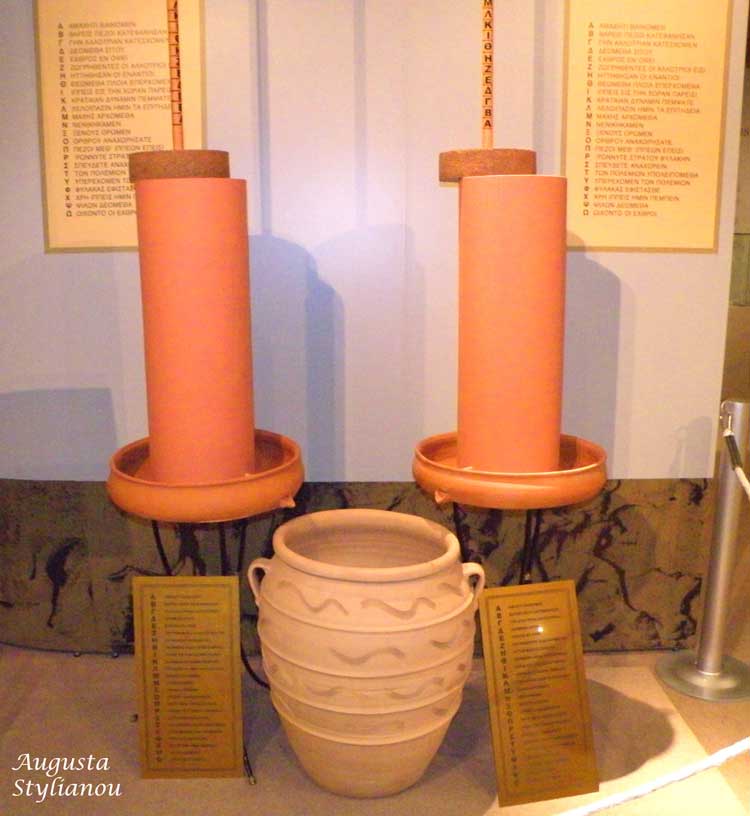So, on the Roman steam engine thread, there was a lot of discussion on the Romans using semaphore lines and horse drawn railcarts. Someone suggested we make a new thread for this so we could delve more fully into the topic, and I concur.
Now I thought I'd do a little research on semaphore lines, and I was interested to find that the Greeks during the Hellenistic Age in the 4th century BC , toyed with hydraulic telegraphs. What I found even more interesting, was that, according to Polybius, this was used during the First Punic War for sending messages from Sicily to Carthage.
If I may quote Polybius here:
We hear almost nothing about this after Polybius. Why did it fall out of use, not to be reinvented for 2,000 years, in 19th century Britain? Especially since, unlike a lot of other Greek scientific achievements during the Hellenistic Era, this one would be very useful to the Roman military for them to adopt, as they were wont to do.
Now on to horse drawn rails. I am not all too familiar with this, but here's what I can guess: The ruts could certainly be made out of wood, since they would not be as worn out as they would be with a steam powered train. Also, transport by land was expensive during the imperial period, and of course traversing the Mediterranean by sea during the winter was perilous in many spots. How much cheaper could horse drawn rails make transport by land?
Discuss!
Now I thought I'd do a little research on semaphore lines, and I was interested to find that the Greeks during the Hellenistic Age in the 4th century BC , toyed with hydraulic telegraphs. What I found even more interesting, was that, according to Polybius, this was used during the First Punic War for sending messages from Sicily to Carthage.
If I may quote Polybius here:
Polybius said:Aeneas, the author of the work on strategy, [writing] to find a remedy for the difficulty, advanced matters a little, but his device still fell far short of our requirements, as can be seen from his description of it.
He says that those who are about to [communicate] urgent news to each other by fire signal should procure two earthenware vessels of exactly the same width and depth, the depth being some three cubits and the width one. Then they should have corks made a little narrower than the mouths of the vessels [so that the cork slides through the neck and drops easily into the vessel] and through the middle of each cork should pass a rod graduated in equal section of three finger-breadths, each clearly marked off from the next. In each section should be written the most evident and ordinary events that occur in war, e.g., on the first, "Cavalry arrived in the country," on the second "Heavy infantry," on the third "Light-armed infantry," next "Infantry and cavalry," next "Ships," next "Corn," and so on until we have entered in all the sections the chief contingencies of which, at the present time, there is a reasonable probability in wartime. Next, he tells us to bore holes in both vessels of exactly the same size, so that they allow exactly the same escape.
Then we are to fill the vessels with water and put on the corks with the rods in them and allow the water to flow through the two apertures. When this is done it is evident that, the conditions being precisely similar, in proportion as the water escapes the two corks will sink and the rods will disappear into the vessels. When by experiment it is seen that the rapidity of escape is in both cases the same, the vessels are to be conveyed to the places in which both parties are to look after the signals and deposited there. Now whenever any of the contingencies written on the rods occurs he tells us to raise a torch and to wait until the corresponding party raises another. When both the torches are clearly visible the signaler is to lower his torch and at once allow the water to escape through the aperture. Whenever, as the corks sink, the contingency you wish to communicate reaches the mouth of the vessel he tells the signaler to raise his torch and the receivers of the signal are to stop the aperture at once and to note which of the messages written on the rods is at the mouth of the vessel. This will be the message delivered, if the apparatus works at the same pace in both cases.
We hear almost nothing about this after Polybius. Why did it fall out of use, not to be reinvented for 2,000 years, in 19th century Britain? Especially since, unlike a lot of other Greek scientific achievements during the Hellenistic Era, this one would be very useful to the Roman military for them to adopt, as they were wont to do.
Now on to horse drawn rails. I am not all too familiar with this, but here's what I can guess: The ruts could certainly be made out of wood, since they would not be as worn out as they would be with a steam powered train. Also, transport by land was expensive during the imperial period, and of course traversing the Mediterranean by sea during the winter was perilous in many spots. How much cheaper could horse drawn rails make transport by land?
Discuss!



